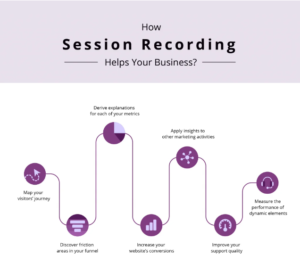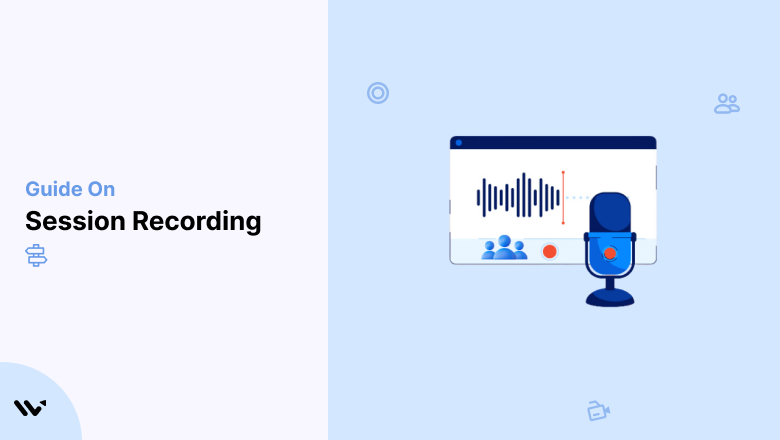Have you ever wondered what goes on behind the scenes when someone visits your web page or website?
Session recording captures every click, scroll, and form filled in real-time during a website session.
This data lets you see it for yourself, identify problems, and optimize your website for a frictionless experience.
From boosting conversions to improving user experience, session recording is a powerful tool to supercharge your website.
Let’s see how this can change everything you know about user behavior.
What Is User Session Recording?

Session recording is a real-time technology that captures a user’s interactions during a website session or application usage. It captures everything from mouse movements and clicks to scrolls, form fills, and page navigation.
This data is stored and can be replayed later to analyze user behavior, identify areas of difficulty, and pinpoint opportunities for improvement.
Why Do You Need Session Recordings?
User recordings give you a deep look into user behavior that traditional analytics can’t. Recording and analyzing user sessions can help identify problem areas in forms or pages, optimize conversion funnels, and collect actionable insights on visitor interactions to enhance the overall user experience.
Here’s why:
Uncover Hidden User Pain
- Find usability issues: See where users get stuck during a website session on your website or app.
- Uncover unknown problems: Discover problems users face that you didn’t even know existed.
- See user frustration: Session replays allow you to watch how users react to error messages or slow load times, providing a clear view of their frustration.
Optimize User Experience
- Layout website: See how users interact with different page elements to optimize their placement.
- Navigation: Find confusing or unclear navigation paths and simplify the user journey. Website session recordings allow you to analyze visitors’ journeys over multiple pages, enhancing your understanding of user experience and optimizing website elements like forms and calls to action.
- Personalize user experience: Tailor content and recommendations based on what you observe.
Convert More
- Conversion barriers: See where users drop off during a website session in the conversion process.
- CTAs: Find the best placement and wording for CTAs.
- Cart abandonment: See what users do before they abandon their cart to fix.
Support Better
- Issue resolution: See how users interact with support channels to simplify processes.
- Training: Find knowledge gaps in your support team based on common user issues.
- Proactive support: See what users need before they ask. Website session replay tools capture user behavior, such as scrolling and taps, allowing support executives to understand issues from the customer’s perspective and provide more effective solutions.
Test Design and Marketing
- Measure design: See how well your design matches user expectations during a website session.
- Test campaigns: Session recordings let you track how users interact with your site after seeing different marketing campaigns. This helps you refine your strategy based on what works best.
- Find winning content: User activity tracking helps you identify which content captures your users’ attention and drives engagement. Analyzing this data allows you to create more effective content for better results.
With session recordings, you can outperform the competition by delivering great user experiences, converting more, and making data-driven decisions.
How Session Recording Can Improve Website Usability and Conversion Rates
1. See the Visitor’s Journey
Session recordings show you how visitors navigate your site during a website session. Every click, scroll, and interaction is recorded from when they arrive to when they leave one page.
This detailed data gives you super-deep insights into user behavior so you can see what they are doing and why. By watching how visitors experience your site, you can put yourself in their shoes and find the bottlenecks and areas for improvement.
2. See Where Users are getting stuck
Session recordings reveal how users interact with your website in real time. By replaying these sessions, you can spot where users get stuck, whether it’s confusing navigation, tricky forms, or unclear CTAs.
This insight lets you fix issues, improve user experience, and boost conversions.
For example, you can analyze forms to see where users hesitate, making it easier to optimize their journey.
3. See the “Why” Behind Your Numbers
Traditional analytics tools provide metrics like conversion and bounce rates but don’t explain why they happen. Session recordings, however, offer qualitative insights into user interactions, showing the reasons behind the numbers.
Tools like Google Analytics give marketers and UX designers data to spot areas for improvement, while session recordings provide deeper, more actionable insights for a complete analysis.
For instance, you can see why users abandon their shopping carts, click away from your primary call to action, or why your bounce rate is unexpectedly high.
With these insights, you can run targeted experiments to optimize your website, addressing issues to boost conversion rates, reduce bounce rates, and enhance the overall user experience.
4. Can You Boost Conversions with Session Recordings?
What You’ll Gain with Session Recordings
- Observe how visitors navigate your site and pinpoint where they’re getting stuck.
- Focus on specific user groups based on their actions, events, or location for deeper insights.
- Discover where users leave your site and make targeted changes to enhance their journey.
- Gain insights that help you create a more intuitive and enjoyable experience for your visitors.
You’ll discover what traditional analytics miss with session recordings, helping you make informed decisions and boost conversions!
5. Know Campaign Performance with Session Recordings
Website session recordings are a powerful tool for measuring campaign performance. You can evaluate how each campaign is doing by categorizing recordings based on referral sources or UTM parameters.
For example, you can assess the quality of traffic from specific ad campaigns, identifying high-intent visitors, low-quality leads, and even bot traffic.
This insight is crucial for optimizing ad spend and selecting the best channels. Session recordings provide a clearer view of campaign performance, enabling you to make data-driven decisions that enhance your marketing ROI.
6. Record Sessions for Better Support
Customer satisfaction is closely linked to support quality, but troubleshooting can be challenging due to vague issue descriptions and missing information. Support agents often struggle to find solutions without understanding the customer’s experience.
Website session recordings address this issue by effectively monitoring user interactions, especially on mobile devices.
By replaying these recordings, support teams gain valuable insights into user behavior, helping them understand issues from the customer’s perspective and resolve them more efficiently.
Incorporating session recordings into your support workflow can significantly enhance both customer experience and support quality.
7. How to Measure Dynamic Elements
Measuring dynamic elements like pop-ups, drop-downs, and personalized content is crucial for user experience and conversions. Traditional analytics can’t fully capture how users interact with these features.
Session recording tools visually capture user behavior, showing how they interact with dynamic content. Analyzing this helps you identify friction points, assess the effectiveness of forms and design elements, and boost conversion rates.
Unlike traditional analytics, session recordings show the complete picture of user interactions and static and dynamic content, allowing you to make data-driven decisions.
5-Step Guide to Session Recording
Session recording is a powerful way to see user behavior. Let’s break it down into a step-by-step approach to using this tool:
Step 1. Set Clear Objectives
Before diving into session recordings, define your goals. What are you hoping to achieve? Are you looking to improve user experience, boost conversions, or spot usability issues? Having clear objectives will focus your analysis and help you make better decisions.
Step 2. Choose the Right Session Recording Tool
There are many website session recording tools available. When choosing a tool, consider ease of use, data privacy, features, and cost. A tool that integrates with your existing tech stack and gives you granular control over data collection is perfect.
Step 3. Implement and Configure
Install the chosen tool’s tracking code on your website. Decide which pages to record and define specific user segments for targeted data analysis only. Consider traffic volume and behavior when making these decisions.
Step 4. Analyze User Behavior
Review recorded sessions to see patterns, pain points, and opportunities. Segment user data by demographics, behavior, or other relevant criteria. Use heat maps, click maps, and other visualization tools to help with your analysis.
Step 5. Test and Iterate
Based on your findings, create hypotheses and test potential changes through A/B testing or other experimentation methods. Analyze results and refine.
Remember:
- Data Privacy: Anonymize sensitive data and follow data protection laws.
- Data Volume: Manage data to avoid overwhelming your system. Consider data retention and sampling.
- Integration: Combine session recording with other analytics tools to get the full picture.
By following these and keeping it data-driven, you can get the most out of session recording and improve your website and user experience.
Best Practices for Session Recordings
Session recordings can be a powerful tool for understanding user behavior and improving website performance. However, to get the most out of session recordings, following best practices is essential. Here are some tips to help you get started:
- Set Clear Goals Before starting a session recording exercise, define your goal. Are you looking to improve user experience, increase conversions, or identify usability issues? Clear objectives will help you focus on specific areas of your website and ensure that you’re collecting relevant data.
- Choose the Right Tool Select a session recording tool that fits your business needs. Consider factors such as ease of use, cost, and features. An ideal tool integrates seamlessly with your existing tech stack and offers robust data privacy controls.
- Configure Settings Correctly Configure the tool’s settings and parameters to ensure you’re collecting the correct data. Decide which pages to record and define specific user segments for targeted analysis.
- Watch Enough Recordings Watch enough recordings to get a representative sample of user behavior. This will help you identify patterns and trends, providing a comprehensive view of how users interact with your website.
- Analyze and Validate Analyze the data you’ve collected and validate your findings through testing. Use heatmaps, click maps, and other visualization tools to help with your analysis. By validating your insights, you can make informed decisions about optimizing your website.
By following these best practices, you can leverage session recordings to gain valuable insights into user behavior and make data-driven improvements to your website.
Using Session Recordings for Business Growth
Session recordings can be a valuable tool for driving business growth. By understanding how users interact with your website, you can identify areas for improvement and make data-driven decisions.
Here are some ways to use session recordings for business growth:
- Improve User Experience: Use session recordings to identify areas of friction and improve the overall user experience. By watching how users navigate your site, you can pinpoint confusing elements and optimize them for a smoother journey.
- Increase Conversions: Analyze session recordings to identify barriers to conversion and make changes to improve conversion rates. For example, you can see where users drop off during checkout and make adjustments to reduce cart abandonment.
- Enhance Customer Support: Use session recordings to understand customer pain points and improve customer support. By seeing how users interact with support channels, you can streamline processes and provide more effective solutions.
- Inform Product Development: Use session recordings to inform product development and ensure new features meet user needs. By understanding how users interact with your site, you can prioritize features with the most significant impact.
By leveraging session recordings, you can gain valuable insights into user behavior and make data-driven decisions to drive business growth.
Industry-Specific Use Cases
Session recordings can be applied to various industries to improve user experience, increase conversions, and drive business growth. Here are some industry-specific use cases:
eCommerce
- Improve Checkout Process: Watch user behavior to spot friction points in checkout and boost conversions by making necessary adjustments.
- Enhance Product Pages: Analyze user interactions to improve product descriptions, images, and reviews, creating pages that drive sales.
- Optimize Search: Understand how users search and refine search results and filters to make finding products easier.
B2B SaaS
- Improve Onboarding: Track how new users navigate onboarding and tweak the flow for a smoother experience that boosts adoption.
- Enhance Feature Usage: Observe how users interact with features, improving tutorials and documentation to encourage better usage.
- Optimize Support: See where users struggle with support, streamlining processes to provide faster, more effective solutions.
Travel
- Improve Booking Process: Identify friction in the booking flow and make targeted adjustments to increase conversions.
- Enhance Destination Pages: Review user actions to refine images, reviews, and descriptions, creating more engaging destination pages.
- Optimize Search: Monitor how travelers search and refine filtering options to make it easier to find the right travel options.
By applying session recordings to these industry-specific use cases, you can gain valuable insights into user behavior and make data-driven decisions to improve user experience and drive business growth.
Challenges and Solutions in Session Recordings
Session recordings are gold but come with their problems.
Let’s review some common issues and solutions related to website session recordings.
Challenges
- Data Overload: With so many recorded sessions, finding what you need is hard.
- Privacy: Handling user data is key to trust and compliance.
- Technical Issues: Recording quality, slow playback, and compatibility can be problematic.
- Time-Consuming: Watching countless recordings to get meaningful insights is time-consuming.
- Finding Actionable Insights: Turning data into actionable recommendations is hard.
Solutions
- Data Segmentation and Filtering: Use advanced filtering to focus on specific user groups, behaviors, or conversion paths.
- Data Anonymization: Remove personally identifiable information from recordings to protect user privacy.
- Robust Platform: Choose a session recording tool that performs well and is compatible across devices.
- AI: Use AI to automate the analysis and find trends, patterns, and anomalies.
- Clear Objectives: Define your goal before analyzing recordings to focus on the right data and insights.
- User Testing: Combine session recordings with qualitative research methods like user interviews to validate findings.
Bonus
- Focus on High-Value Sessions: Record users about to convert or have hit a chance to get converted during a website session.
- Use Heatmaps and Click Maps: These visual tools complement session recordings by showing aggregated data on user interactions.
- Integrate with Other Tools: Combine session recordings with website analytics to fully understand user behavior.
- Review and Refine Regularly: Monitor the effectiveness of your session recording strategy and adjust as needed.
By solving these challenges and doing this right, you can get the most out of session recordings and see real improvements on your website or app.
Conclusion
Website session recordings show how visitors move through different pages on your website, like a movie of their clicks and scrolls.
This reveals the problems they can’t see, like confusing layouts or unclear CTAs. You can then use this insight to improve the user experience and conversions on the landing page.

